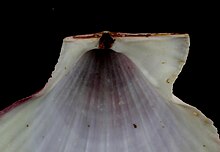
In anatomy, a resilium is part of the shell of certain bivalve mollusks. It is an internal ligament, which holds the two valves together and is located in a pit or depression known as the resilifer.
The resilium is part of the hinge mechanism in certain taxonomic families of bivalve shells, such as oysters and scallops.[1][2][3] A resilium (and the resilifer, its associated contact point) is the primary structure comprising the type of bivalve hinge that is known as an "disodont" hinge.
References[edit]
- ^ "Bivalves - General Morphology". Paleontological Laboratory at SUNY Cortland. Archived from the original on 29 January 2020. Retrieved 13 October 2021.
- ^ Leal, J.H. "Bivalves" (PDF). Bailey-Matthews National Shell Museum. Archived from the original (PDF) on 10 April 2004. Retrieved 13 October 2021.
- ^ Dr. Burt Carter. "Invertebrate Paleobiology on-line syllabus on Bivalves". Georgia Southwestern State University. Archived from the original on 25 February 2020. Retrieved 13 October 2021.
Well, that’s interesting to know that Psilotum nudum are known as whisk ferns. Psilotum nudum is the commoner species of the two. While the P. flaccidum is a rare species and is found in the tropical islands. Both the species are usually epiphytic in habit and grow upon tree ferns. These species may also be terrestrial and grow in humus or in the crevices of the rocks.
View the detailed Guide of Psilotum nudum: Detailed Study Of Psilotum Nudum (Whisk Fern), Classification, Anatomy, Reproduction